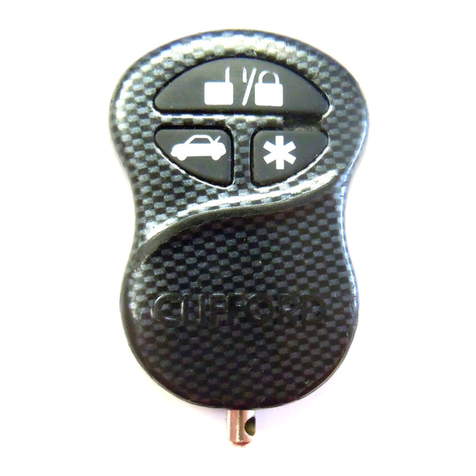
Passenger Compartment Connections
Brake Switch
The brake switch connection is required for the operation of the IntelliGuard 8000’s anti-carjacking electronics.
1. Turn the ignition to the “ON” position and press the brake pedal to verify that the brake lights ar e operational.
2. Find the one wire that carries +12V when the brake pedal is pressed, then connect the BLUE/WHITE wire to this wire.
Parking Lights
See the Door Trigger/Parking light section in this binder.
Starter and Ignition Immobilization Circuits
1.Locate the ignition switch wireloom under the dash and use a voltmeter to locate the one wire that carries +12V throughout
BOTH the cranking AND engine running cycles, and 0 volts when the ignition is off.
2. Start the engine, then cut the ignition wire. The engine should stop running.
3.As shown on page 5, connect the WHITE/BROWN wire to the key sideof the cut ignition line.
4.Connect the GREEN/BLUE wire to the engine side of the cut ignition line.
5.Use a voltmeter to locate the one wire that carries +12V during the cranking cycle ONLY. Cut this wire, then try to start the
engine. It should not crank.
6. Connect the WHITE/GREEN wire to the key sideof the cut starter line.
7.Connect the WHITE/BLUE wire to the engine side of the cut starter line.
NOTE:Thestartercircuitmaycarryaveryhigh current.Be certainthat thestarter wireconnections are solid.
Auxilliary Output A with Selectable Output Type
The output (GRAY/VIOLET wire) can be programmed as either pulsed, latched or timed and can be progr ammed to operate only
when the system is disarmed (e.g., for use as a remote trunk release). The output is activated by transmitting channel 2 from the 16-
channel master remote control or by pressing the button on the companion remote. The factory setting is pulsed output (0.5
second ground). The latched output stays at ground until channel 2 is activated a second time, and the timed output stays at ground
for any selected duration between one second and four minutes. Current is limited to 0.15 amp. See Installer-Programmable Features
page 16 for information on programming the output type and/or disabling operation while the system is disarmed.
Auxilliary Output B with Selectable Output Type
The output (GRAY/BLUE wire) can be programmed as either pulsed, latched or timed and is activated by transmitting channel 7
from the 16-channel master remote control or by pressing the and ✱ buttons on the companion remote. The factory setting is
pulsed output (0.5 second ground). The latched output stays at ground until channel 7 is activateda second time, and the timed
output stays at ground for any selected duration between one second and four minutes. Current is limited to 0.15 amp. See
Installer-Programmable Featureson page 16 for information on programming the output type.
Auxilliary Output C with Selectable Output Type and AutoActivation
The output (GRAY/RED wire) can be programmed as either pulsed, latched, or timed and in addition, can also be programmed to
automatically activate every time the system is armed using the remote control. The output is activated by transmitting channel 8 from
the 16-channel master remote or by pressing and on the companion remote. Current is limited to 0.15 amp. AutoActivation is
perfect when programmed as a timed-output to close the power windows and sunroof on vehicles that h ave an all-close feature. See
Installer-Programmable Featureson page 16 for more information on programming output type and/or enabling the AutoActivation
feature.
Engine Bay Connections
High Output Medallion Siren
Mount the siren in the engine compartment away from hot or moving parts and where it cannot be reac hed from under the vehicle,
preferable opposite the exhaust system. Point the siren down to avoid water collection (see the il lustration).
1.You must firmly secure the siren to the engine bay firewall or an fender well using all three sheetmetal screws supplied.
2.Using the supplied connector, fasten the GRAY twinlead wire coming from the siren to the BLACKtwinlead from the 24-pin
connector on the control unit.
IntelliGuard 8000/2997


































